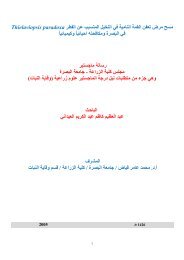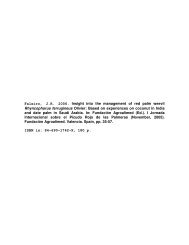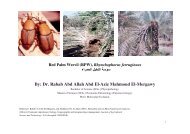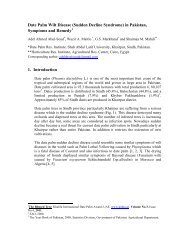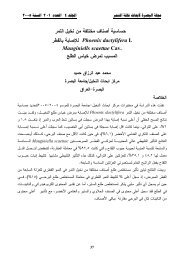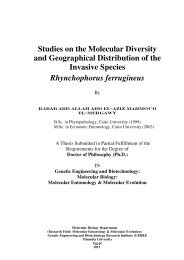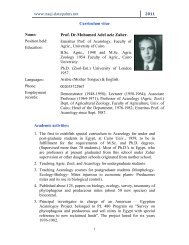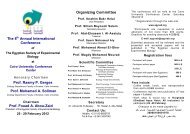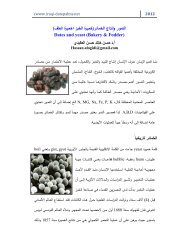The red palm weevil as an alien invasive: biology and the prospects ...
The red palm weevil as an alien invasive: biology and the prospects ...
The red palm weevil as an alien invasive: biology and the prospects ...
You also want an ePaper? Increase the reach of your titles
YUMPU automatically turns print PDFs into web optimized ePapers that Google loves.
44N BiocontrolNews <strong>an</strong>d Information 1999 Vol. 20 No. 1<br />
rele<strong>as</strong>e h<strong>as</strong> been proposed. <strong>The</strong> e<strong>as</strong>e of rele<strong>as</strong>e of <strong>the</strong>se agents in <strong>the</strong><br />
countries of <strong>the</strong> Gulf will depend on <strong>the</strong>ir country of origin <strong>an</strong>d <strong>the</strong><br />
level of host specificity <strong>the</strong>y display in laboratory tests.<br />
It is worth noting that in 1990 total world sales of biopesticides w<strong>as</strong><br />
valued at US$120 million <strong>an</strong>d this total w<strong>as</strong> estimated to represent<br />
only 0.5% of <strong>the</strong> world agrochemical market. Bacillus thuringiensis<br />
Berliner (Bt) sales accounted for 90% of this total but growth of <strong>the</strong><br />
sector is rapid, at between 10-25% p.a., <strong>an</strong>d exp<strong>an</strong>sion of <strong>the</strong> market<br />
is likely to continue <strong>as</strong> alternatives for chemicals are sought <strong>an</strong>d<br />
discove<strong>red</strong> (Neale, 1997). <strong>The</strong> types of agent with proven<br />
biopesticide utility are mentioned below.<br />
<strong>The</strong> use of <strong>the</strong> bacterium Bacillus thuringiensis is now widespread<br />
in m<strong>an</strong>y agricultural systems but a major drawback with <strong>the</strong> use of<br />
Bt is <strong>the</strong> build up of resist<strong>an</strong>ce to <strong>the</strong> bacterial toxin in a target insect<br />
population. <strong>The</strong>re are well-documented c<strong>as</strong>es of resist<strong>an</strong>ce arising<br />
through <strong>the</strong> over or misuse of Bt. For example, in Sou<strong>the</strong><strong>as</strong>t Asia <strong>the</strong><br />
rapid development of resist<strong>an</strong>ce in <strong>the</strong> diamondback moth, Plutella<br />
xylostella (L.) (Lep., Plutellidae) demonstrates that <strong>the</strong> application<br />
strategy for introducing <strong>an</strong>d m<strong>an</strong>aging biopesticides must be in<br />
place before <strong>an</strong>y long term use commences. Control of <strong>palm</strong><br />
<strong>weevil</strong>s h<strong>as</strong> not yet been attempted with Bt <strong>as</strong> no specific strains<br />
have been isolated from <strong>the</strong>se insects, although strains are in culture<br />
from o<strong>the</strong>r types of <strong>weevil</strong>.<br />
<strong>The</strong> use of fungi <strong>as</strong> biopesticides is now well established. A good<br />
example being <strong>the</strong> use of Metarhizium flavoviride Gams &<br />
Rozsypal to control orthopter<strong>an</strong>s (Thom<strong>as</strong> et al., 1995). This fungus<br />
h<strong>as</strong> been successfully formulated in oils <strong>an</strong>d applied, in dry habitats<br />
similar to those found in <strong>the</strong> Gulf, to control <strong>the</strong> desert locust<br />
Schistocerca gregaria (Forskål) <strong>an</strong>d <strong>the</strong> gr<strong>as</strong>shopper Zonocerus<br />
variegatus (L.) (Acrididae). <strong>The</strong> ch<strong>an</strong>ces of finding <strong>an</strong>d<br />
characterizing similar fungal agents from <strong>red</strong> <strong>palm</strong> <strong>weevil</strong> specimens<br />
will be high.<br />
From <strong>the</strong> USA, China, Austral<strong>as</strong>ia <strong>an</strong>d Europe, <strong>the</strong>re are examples<br />
of effective control with entomopathogenic nematodes (EPNs)<br />
belonging to <strong>the</strong> families Steinernematidae <strong>an</strong>d Heterorhabditidae.<br />
In <strong>the</strong> USA EPNs are regularly applied over large are<strong>as</strong> to high<br />
value crops such <strong>as</strong> cr<strong>an</strong>berries. In China Carposina niponensis<br />
(Walsingham) (Lep., Carposinidae) is regularly controlled by <strong>the</strong><br />
application of Steinernema carpocapsae (Weiser) (Rhabditida:<br />
Steinernematidae) around apple trees, <strong>an</strong>d shade trees have been<br />
injected with suspensions of S. carpocapsae to control <strong>the</strong> cossid<br />
borers Holcocerus insularis St<strong>an</strong>dinger <strong>an</strong>d Zeuzera multistrigata<br />
Moore (Lep., Cossidae). In Europe <strong>the</strong> successes of EPNs are<br />
limited to pests of high value protected crops such <strong>as</strong> ornamental<br />
pl<strong>an</strong>ts which are treated with Heterorhabditis spp. to control <strong>the</strong><br />
black vine <strong>weevil</strong> Otiorhynchus sulcatus (F.) (Col., Curculionidae)<br />
or to mushrooms treated with Steinernema feltiae (Filipijev)<br />
(Steinernematideae) for <strong>the</strong> control of mushroom sciarid <strong>an</strong>d phorid<br />
flies.<br />
<strong>The</strong> potential for using EPNs h<strong>as</strong> been reviewed by H<strong>an</strong>ounik<br />
(1998). From this review it is known that larvae of <strong>red</strong> <strong>palm</strong> <strong>weevil</strong><br />
are susceptible to infection by nematodes, with very encouraging<br />
results obtained in laboratory tests, but so far attempts at control in<br />
<strong>the</strong> field have been less successful (Abuzuhairah, pers. comm.). In<br />
such c<strong>as</strong>es, however, it must be remembe<strong>red</strong> that biocontrol agents<br />
have to be applied at <strong>the</strong> most opportune time <strong>an</strong>d situation <strong>an</strong>d that<br />
factors such <strong>as</strong> temperature are critical when using biological ra<strong>the</strong>r<br />
th<strong>an</strong> chemical agents.<br />
At present no indigenous strains of <strong>an</strong>y of <strong>the</strong> pathogens listed<br />
above have been isolated in <strong>the</strong> Gulf region. Surveys for indigenous<br />
pathogens should be conducted to find <strong>an</strong>d develop agents that<br />
could be pre-adapted to <strong>the</strong> extremes of temperature encounte<strong>red</strong> in<br />
<strong>the</strong> date farms <strong>an</strong>d gardens of <strong>the</strong> Gulf region.<br />
References<br />
Abraham, V.A. (1971) Note on <strong>an</strong> effective method of preventing entry by<br />
<strong>red</strong>-<strong>weevil</strong>, Rhynchophorus ferrugineus Fabricius (Curculionidae:<br />
Coleoptera), into <strong>the</strong> stem of coconut <strong>palm</strong> through cut petioles. Indi<strong>an</strong><br />
Journal of Agricultural Sciences 41, 1130-1131.<br />
Abraham, V.A.; Kuri<strong>an</strong>, C.; Nayer, N.M. (1973) Chelisoches morio F.<br />
(Forficulidae: Dermaptera), a p<strong>red</strong>ator on eggs <strong>an</strong>d early instar grubs of<br />
<strong>the</strong> <strong>red</strong> <strong>palm</strong> <strong>weevil</strong> Rhynchophorus ferrugineus F. (Curculionidae:<br />
Coleoptera). Journal of Pl<strong>an</strong>tation Crops 1, 147-152.<br />
Abraham, V.A.; Koya, K.M.A.; Kuri<strong>an</strong>, C. (1975) Evaluation of seven<br />
insecticides for control of <strong>red</strong> <strong>palm</strong> <strong>weevil</strong> Rhynchophorus ferrugineus<br />
Fabr. Journal of Pl<strong>an</strong>tation Crops 3, 71-72.<br />
Abraham, V.A.; Koya, K.M.A.; Kuri<strong>an</strong>, C. (1989) Integrated m<strong>an</strong>agement of<br />
<strong>red</strong> <strong>palm</strong> <strong>weevil</strong> (Rhynchophorus ferrugineus F.) in coconut gardens.<br />
Paper presented at <strong>the</strong> 7th Symposium on Pl<strong>an</strong>tation Crops, Coonoor,<br />
India, 16-19 October 1986. Journal of Pl<strong>an</strong>tation Crops 16, supplement,<br />
159-162.<br />
Abraham, V.A.; Al Shuaibi, M.A.; Faleiro, J.R.; Abuzuhairah, R.A.;<br />
Vidy<strong>as</strong>agar, P.S.P.V. (1998) An integrated m<strong>an</strong>agement approach for<br />
<strong>red</strong> <strong>palm</strong> <strong>weevil</strong>, Rhynchophorus ferrugineus Oliv., a key pest of date<br />
<strong>palm</strong> in <strong>the</strong> Middle E<strong>as</strong>t. Sult<strong>an</strong> Qabus University Journal for Scientific<br />
Research, Agricultural Sciences 3, 77-84.<br />
Abuzuhairah, R.A.; Vidy<strong>as</strong>agar, P.S.P.V.; Abraham, V.A. (1996) Integrated<br />
pest m<strong>an</strong>agement of <strong>red</strong> <strong>palm</strong> <strong>weevil</strong> Rhynchophorus ferrugineus F. in<br />
date <strong>palm</strong> pl<strong>an</strong>tations of <strong>the</strong> Kingdom of Saudi Arabia. Proceedings, XX<br />
International Congress of Entomology, Firenze, Italy, 25-31 August<br />
1996, 541 pp.<br />
Anon. (1998) Slow death in Arabia: date <strong>palm</strong>s face extinction. <strong>The</strong> Middle<br />
E<strong>as</strong>t, February 1998, pp. 49-50.<br />
Av<strong>an</strong>d Faghih, A. (1996) <strong>The</strong> <strong>biology</strong> of <strong>red</strong> <strong>palm</strong> <strong>weevil</strong>, Rhynchophorus<br />
ferrugineus Oliv. (Coleoptera, Curculionidae) in Sarav<strong>an</strong> region (Sist<strong>an</strong><br />
& Balouchist<strong>an</strong> Province, Ir<strong>an</strong>). Applied Entomology <strong>an</strong>d Phytopathology<br />
63, 16-18.<br />
B<strong>an</strong>erjee, A.; D<strong>an</strong>gar, T.K. (1995) Pseudomon<strong>as</strong> aeruginosa, afacultative<br />
pathogen of <strong>red</strong> <strong>palm</strong> <strong>weevil</strong>, Rhynchophorus ferrugineus. World<br />
Journal of Micro<strong>biology</strong> <strong>an</strong>d Biotechnology 11, 618-620.<br />
Bedford, G.O. (1974) Par<strong>as</strong>itism of <strong>the</strong> <strong>palm</strong> <strong>weevil</strong> Rhynchophorus bilineatus<br />
(Montrouzier) (Coleoptera: Curculionidae) by Praecocilenchus<br />
rhaphidophorus (Poinar) (Nematoda: Aphelenchoidea) in New Britain.<br />
Journal of <strong>the</strong> Australi<strong>an</strong> Entomological Society 13, 155-156.<br />
Borror, D.J.; Delong, D.J.; Triplehorn, C.A. (1964) An introduction to <strong>the</strong><br />
study of insects, 4th edition. New York; Holt, Rinehart & Winston, 852<br />
pp.<br />
Bokhari, U.G.; Abuzuhairah, R.A. (1992) Diagnostic tests for <strong>red</strong><strong>palm</strong> <strong>weevil</strong>,<br />
Rhynchophorus ferrugineus infested date <strong>palm</strong> trees. Arab Journal of<br />
Scientific Research 10, 93-104.<br />
But<strong>an</strong>i, D.K. (1975). Insect pests of fruit crops <strong>an</strong>d <strong>the</strong>ir control – 15: date<br />
<strong>palm</strong>. Pesticides 9, 40-42.<br />
Buxton, P.A. (1920) Insect pests of dates <strong>an</strong>d <strong>the</strong> date <strong>palm</strong> in Mesopotamia<br />
<strong>an</strong>d elsewhere. Bulletin of Entomological Research 11, 287-303.<br />
Clausen, C.P. (1940) Entomophagous insects. New York; McGraw-Hill, 688<br />
pp.<br />
Collenette, S. (1985) Flowers of Saudi Arabia. London; Scorpion, 514 pp.<br />
Cox, M.L. (1993) Red <strong>palm</strong> <strong>weevil</strong>, Rhynchophorus ferrugineus in Egypt.<br />
FAO Pl<strong>an</strong>t Protection Bulletin 41, 30-31.<br />
El-Ezaby, F.A. (1997) Injection <strong>as</strong> a method to control <strong>the</strong> <strong>red</strong> Indi<strong>an</strong> date<br />
<strong>palm</strong> <strong>weevil</strong> Rhynchophorus ferrugineus. Arab Journal of Pl<strong>an</strong>t<br />
Protection 15, 31-38.<br />
El-Garhy, M.E. (1996) Field evaluation of <strong>the</strong> aggregation pheromone of <strong>the</strong><br />
<strong>red</strong> <strong>palm</strong> <strong>weevil</strong>, Rhynchophorus ferrugineus, in Egypt. Brighton Crop<br />
Protection Conference: Pests & Dise<strong>as</strong>es: Volume 3: Proceedings of <strong>an</strong><br />
International Conference, Brighton, UK, 18-21 1059-1064.<br />
FAO (1996) Code of Conduct for <strong>the</strong> Import <strong>an</strong>d Rele<strong>as</strong>e of Exotic Biological<br />
Control Agents. International St<strong>an</strong>dards for Phytos<strong>an</strong>itary me<strong>as</strong>ures<br />
(ISPM) Publication No. 3. Rome, Italy; Food <strong>an</strong>d Agriculture<br />
Org<strong>an</strong>ization of <strong>the</strong> United Nations.<br />
Gerber, K.; Giblin-Davis, R.M. (1990) Association of <strong>the</strong> <strong>red</strong> ring nematode<br />
<strong>an</strong>d o<strong>the</strong>r nematode species with <strong>the</strong> <strong>palm</strong> <strong>weevil</strong>, Rhynchophorus<br />
<strong>palm</strong>arum. Journal of Nematology 22, 143-149.<br />
Giblin-Davis, R.M.; Weissling, T.J.; Oehlschlager, A.C.; Gonzalez, L.M.<br />
(1994) Field response of Rhynchophorus cruentatus (Coleoptera:<br />
Curculionidae) to its aggregation pheromone <strong>an</strong>d fermenting pl<strong>an</strong>t<br />
volatiles. Florida Entomologist 77, 164-177.<br />
Giblin-Davis, R.M.; Oehlschlager, A.C.; Perez, A.; Gries, G.; Gries, R.;<br />
Weissling, T.J.; Chinchilla, C.M.; Pena, J.E.; Hallett, R.H.; Pierce, H.D.,<br />
Jr.; Gonzalez, L.M. (1996) Chemical <strong>an</strong>d behavioral ecology of <strong>palm</strong><br />
<strong>weevil</strong>s (Curculionidae: Rhynchophorinae). Florida Entomologist 79,<br />
153-167.



